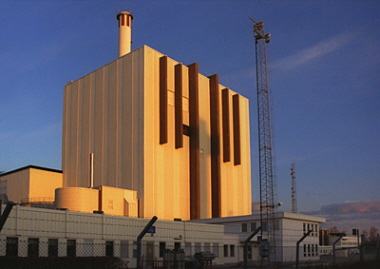Maintenance outages at Forsmark 3 and Oskarshamn 3 have been extended after defects were found in control rods. The units, totalling 2323 MWe of capacity, are not expected to restart until the end of November or early December.
 |
| Forsmark nuclear power plant (Image: Hans Blomberg) |
The problems were first discovered last week during an annual maintenance outage at OKG's Oskarshamn 3, where a fracture was discovered in a control rod shaft. Similar cracks were subsequently discovered in six more control rods, and the company is now extending its maintenance outage to enable it to carry out fuller tests and to determine the root cause of the problem.
No problems have been found at the other two Oskarshamn units, but OKG has notified Nordic power exchange Nordpool that it does not expect unit 3 to restart until 3 December. The boiling water reactor normally supplies 1153 MWe.
In the light of the Oskarshamn discovery, Swedish radiation safety authority SSM called for immediate inspections at Swedish plants sharing similar control rod designs. Inspections at Forsmark 3 have revealed similar problems to those at Oskarshamn. No problems were found in the other two units at the site, which have a different control rod design to the affected plants.
Forsmark's operator Vattenfall has notified Nordpool that Forsmark 3 has "the same problem as Oskarshamn 3" and that "so far we have found that one full length control rod cluster is broken and a few other control rod clusters have indications of cracking." The company says that Forsmark 3 is not expected to restart until 28 November at the earliest. Forsmark 3 can produce 1170 MWe.
SSM also notified its Finnish counterpart, Stuk, so that checks could be carried out at the Olkiluoto plant which uses similar control rods, but Stuk reports that no damage has been found there.
Control rods are made of neutron-absorbing material such as cadmium, hafnium or boron, and are inserted into the reactor's core, or withdrawn from it, to control the rate of the nuclear fission reaction or to halt the process completely and shut the reactor down. They play a vital role in reactor safety. Damage to the extenders, or shafts, through which the rods are inserted into the reactor, could potentially affect the efficacy of the control rods. The units in question each have over 100 such control rods.
Sweden has 10 operating nuclear reactors and relies on nuclear for 46% of its electricity, with most of the rest coming from hydro. Oskarshamn and Forsmark are both currently in their annual maintenance outages, timed to take place over the summer when Swedish electricity demand is at its lowest. However, the extension of the outages sees the restart of some 2323 MWe of generation capacity pushed closer to the coldest months of December, January, February and March.





_63865.jpg)
_18570.jpg)
_16159.jpg)





